Starlix dosages: 120 mg
Starlix packs: 30 pills, 60 pills, 90 pills

Order discount starlix line
A very versatile catheter with a small balloon near the tip can be inserted into a peripheral vein. By monitoring the stress changes, the physician can advance the catheter tip into the pulmonary artery. The Fick principle can be used to estimate the O2 consumption of organs when blood move and the O2 content of arterial and venous blood could be decided. Algebraic rearrangement reveals that O2 consumption equals blood flow multiplied by the difference within the arteriovenous O2 focus. For example, if blood move via one kidney is 700 mL/minute, the arterial O2 content material is 0. In the clinic, cardiac output is mostly measured noninvasively with Doppler echocardiography. Obtaining the cross-sectional area of the aorta (also measured by echocardiography) allows the amount of blood ejected in a single beat. Multiplying stroke volume by the guts price then yields a value for cardiac output in liters per minute. The O2 content of cardiac venous blood is normally low (5 mL/ dL), and the myocardium can obtain little additional O2 by additional extraction of O2 from coronary blood. Therefore, elevated O2 demands of the center must be met mainly by a rise in coronary blood flow (see Chapter 17). In experiments during which the heartbeat is arrested however coronary perfusion is maintained, O2 consumption falls to 2 mL/ minute/100 g or less, which is still six to seven occasions greater than the O2 consumption of resting skeletal muscle. Left ventricular work per beat (stroke work) is roughly equal to the product of stroke quantity and the mean aortic pressure against which the blood is ejected by the left ventricle. Thus myocardial O2 consumption may not be properly correlated with general cardiac work. The magnitude and length of left ventricular strain are correlated with left ventricular O2 consumption. The work of the right ventricle is one-seventh that of the left ventricle as a end result of pulmonary vascular resistance is way lower than systemic vascular resistance. Cardiac Efficiency the effectivity of the guts could also be calculated because the ratio of the work completed to the entire energy used. If the average O2 consumption is assumed to be 9 mL/minute/100 g for the two ventricles, a 300-g coronary heart will eat 27 mL of O2 per minute. This value is equal to 130 small calories when the respiratory quotient is zero. Together, the 2 ventricles do roughly 8 kg-m of labor per minute, which is equivalent to 18. Added to that is kinetic work because of the velocity (v) of blood circulate and the density of blood. However, with excessive cardiac output, as in strenuous train, the kinetic power component can account for up to 50% of total cardiac work. Such measurements are essential as a result of inner work is a large determinant of myocardial O2 want. An various approach to consider cardiac work and its relation to O2 consumption has been developed in which P-V loops. Simultaneously halving aortic pressure and doubling cardiac output, or vice versa, end in the identical value for cardiac work. However, the O2 requirements are greater for any given quantity of cardiac work when a significant proportion of the work is strain work, versus volume work. The actual gross mechanical effectivity of the guts is barely larger (18%) than the worth calculated and is set via subtracting the O2 consumption of the nonbeating (asystolic) coronary heart (2 mL/minute/100 g) from the whole cardiac O2 consumption within the calculation of effectivity. This course of occurs during the finish of systole, when cytosolic Ca++ is quickly sequestered into the sarcoplasmic reticulum to provoke diastolic rest. Thus the speed of myocardial O2 consumption is tightly linked to the work price (or power) of the myocardium. Substrate Utilization the heart is flexible in its use of substrates, and within sure limits, uptake of a selected substrate is immediately proportional to its arterial concentration. The use of one substrate by the heart can additionally be influenced by the presence or absence of other substrates.
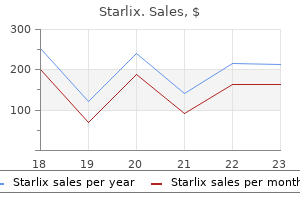
Purchase generic starlix on line
Long-chain fatty acids are shuttled into the mitochondrial matrix by formation of acylcarnitine esters; catalyzed by carnitine acyltransferase. The carnitine shuttle transports long-chain (14-carbon) acetylated fatty acids across the inside mitochondrial membrane. Carnitine acyltransferase I (rate-limiting reaction) on the outer floor of the inner mitochondrial membrane removes the fatty acyl group from fatty acyl CoA and transfers it to carnitine to kind fatty acyl carnitine. Repetition of those 4 reactions finally degrades even-numbered carbon chains completely to acetyl CoA. Insulin (fed state) activates protein phosphatase, which inhibits lipolysis by changing hormone-sensitive lipase into an inactive dephosphorylated kind. Malonyl CoA is the precursor used in fat synthesis, and its focus displays the energetic synthesis of palmitate. Ketone bodies (acetone, acetoacetate, and b-hydroxybutyrate) are used for fuel by muscle (skeletal and cardiac), the mind (starvation), and the kidneys. The ordinary take a look at for measuring ketone our bodies in serum or urine (nitroprusside reaction) only detects acetoacetate and acetone, a spontaneous decomposition product of acetoacetate. Synthesis of ketone bodies happens primarily in the liver from leftover acetyl CoA. Vitamin B12 is a cofactor in odd-chain fatty acid metabolism, and succinyl CoA is used as a substrate for gluconeogenesis. Odd-numbered fatty acids undergo oxidation by the identical pathway as saturated fatty acids, except that propionyl CoA (3 carbons) stays after the ultimate cycle. Propionyl CoA is transformed first to methylmalonyl CoA after which to succinyl CoA, a citric acid cycle intermediate that enters the gluconeogenic pathway. Unsaturated fatty acids are additionally degraded by coming into b-oxidation on the trans-unsaturated intermediate with reduction or rearrangement of the unsaturated bond as needed. Carnitine deficiency or carnitine acyltransferase deficiency impairs using long-chain fatty acids via the carnitine shuttle for power production. Clinical findings embrace muscle aches and fatigue following train, elevated free fatty acids in blood, and reduced ketone manufacturing in the liver during fasting (nonketotic hypoglycemia; acetyl CoA from b-oxidation is important for ketone production). Clinical findings include recurring episodes of hypoglycemia (all tissues are competing for glucose), vomiting, lethargy, and minimal ketone manufacturing within the liver. Clinical findings embody adrenocortical insufficiency and diffuse abnormalities in the cerebral white matter, leading to neurologic disturbances similar to progressive psychological deterioration and spastic paralysis. Jamaican vomiting illness is brought on by eating unripe fruit of the akee tree that incorporates a toxin, hypoglycin. This ends in the accumulation of very-long-chain fatty acids, particularly within the brain. Cholesterol, essentially the most plentiful steroid in human tissue, is essential in cell membranes and is the precursor for bile acids and all the steroid hormones, including vitamin D, which is synthesized in the skin from 7-dehydrocholesterol. The bile acids are a significant product of cholesterol synthesis and are converted into secondary varieties by intestinal bacteria. Deficiencies in the enzymes that convert progesterone to different steroid hormones produce the adrenogenital syndrome (congenital adrenal hyperplasia) because of disruption of normal hypothalamic-pituitary feedback. Cholesterol features: cell membrane, bile acid synthesis, steroid hormone synthesis 7-6: Overview of ldl cholesterol synthesis. Isopentenyl pyrophosphate (containing isoprene) is also a precursor in the synthesis of other mobile molecules: (1) the side chain of coenzyme Q (ubiquinone) (2) Dolichol, which functions in the synthesis of N-linked oligosaccharides in glycoproteins (3) the facet chain of heme a (4) Geranylgeranyl and farnesyl groups that serve as highly hydrophobic membrane anchors for some membrane proteins 4. Reduce ldl cholesterol consumption (1) A 50% reduction in intake solely lowers serum ldl cholesterol by about 5%. Bile salts are primarily used to emulsify fatty acids and monoacylglycerol and package deal them into micelles, together with fat-soluble nutritional vitamins, phospholipids, and cholesteryl esters, for reabsorption by villi in the small bowel (see Chapter 4). Primary bile acids are conjugated earlier than secretion within the bile with taurine (taurochenodeoxycholic acid) or glycine (glycocholic acid). Isoprene, an intermediate in ldl cholesterol synthesis, additionally serves different features in coenzyme Q and membrane anchoring of proteins. Secretion of reabsorbed bile acids is preceded by conjugation with taurine and glycine. Bile salt deficiency leads to malabsorption of fats and fat-soluble vitamins (see Box 4-2 in Chapter 4). Steroid hormones in the adrenal cortex comprise 21 (C21), 19 (C19), or 18 (C18) carbon atoms. Plasma lipoproteins transport the low-solubility lipids, cholesterol, and triglycerides to and from the tissues.
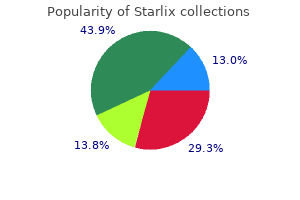
120mg starlix sale
Color Doppler shows elevated blood flow within the infected epididymis and/or testis compared with the asymptomatic aspect. Testicular Torsion Torsion of the testis results when the testis and spermatic wire twist one or more times, obstructing blood flow. With testicular torsion, the testis usually is enlarged and loses its normal echotexture. On colour circulate Doppler, there will be absence of blood move to the middle of the testicle. With torsion and detorsion, one may be led astray by the truth that after detorsion blood returns to the testicle. B, Abnormal waveform with a delay in systolic acceleration indicating a proximal stenosis in the principle renal artery. A, Pulse Doppler tracing of an intraparenchymal segmental renal artery demonstrates a sharp systolic upstroke and steady forward diastolic circulate. Ossification of the femoral head interferes with ultrasound examination past four to 6 months of age. Manipulation of the hip for dynamic examination could additionally be unimaginable within the older, stronger infant. NeonatalSpineUltrasound Tethered Cord Tethered cord, or low-lying conus medullaris, could occur as a primary downside or in association with different components of spinal dysraphism, corresponding to lipomyelomeningocele, hemangioma, or a dermoid tract. Sonographically, tethered wire is recognized in neonates by the presence of low-lying conus (below the L2 to L3 disk space). NeonatalHeadUltrasound Germinal Matrix Hemorrhage the germinal matrix develops deep to the ependyma and consists of proliferating cells that give rise to neurons and glia of the cerebral cortex and basal ganglia. The germinal matrix vascular mattress consists of immature fine capillaries and very thin-walled veins. On ultrasound, germinal matrix hemorrhage is seen as an ovoid echogenic mass throughout the caudothalamic groove. Echogenic material in these segments of the lateral ventricle is in maintaining with blood. Nonetheless, even with this history, the patient ought to be surgically explored and the issue corrected. HipUltrasound Hip Effusion Ultrasound is useful for delineating fluid within the hip joint. At this website, the 2 situations most commonly encountered are transient synovitis and septic arthritis. G1 refers to the gluteus minimus muscle, G2 to the gluteus medius muscle, and G3 to the gluteus maximus muscle. Hounsfield and Cormack have been awarded the 1979 Nobel Prize in Medicine for his or her work. It then makes use of reconstruction algorithms to show the differing densities in a gray-scale picture. More detectors (currently sixty four or more) signifies that fewer x-ray tube rotations are required to cover the same volume of the patient and subsequently data may be acquired extra shortly. A quick scan time within the pediatric age group might permit extra examinations to be carried out with out sedation. The reduced scanning time significantly decreases the respiratory artifact, affecting the lungs particularly. Left parasagittal picture exhibits elevated echogenicity in the caudothalamic groove (arrow). Airway Airway analysis contains assessment of congenital abnormalities, endobronchial or extrinsic processes with airway results. Nonionic intravenous distinction is universally used and has significantly decreased the incidence of contrast reactions. Administration of oral contrast is contraindicated when a patient lacks a gag reflex or might require common anesthesia. Chest Regions and buildings evaluated embrace the lung parenchyma, airway, mediastinum, cardiovascular buildings, and chest wall.

Purchase starlix 120mg visa
When the frequency of sympathetic stimulation will increase from zero to 4 Hz, the center rate will increase by roughly 80 beats per minute in the absence of vagal nerve stimulation (0 Hz). However, when the vagus nerves are stimulated at eight Hz, rising the sympathetic stimulation frequency from 0 to four Hz has solely a negligible influence on coronary heart fee. These fibers emerge from the spinal column via the white speaking branches and enter the paravertebral chains of ganglia. The preganglionic and postganglionic neurons synapse primarily within the stellate or middle cervical ganglia, relying on the species. In the mediastinum, postganglionic sympathetic and preganglionic parasympathetic fibers be a part of to kind a complicated plexus of mixed efferent nerves to the guts. The postganglionic cardiac sympathetic fibers on this plexus approach the bottom of the guts along the adventitial surface of the nice vessels. From the bottom of the heart, these fibers are distributed to the various chambers as an in depth epicardial plexus. In distinction to abrupt termination of the response after vagal activity, the consequences of sympathetic stimulation decay gradually after stimulation is stopped. Nerve terminals take as much as 70% of the norepinephrine released throughout sympathetic stimulation; a lot of the rest is carried away by the bloodstream. Furthermore, the facilitatory results of sympathetic stimulation on the guts attain steady-state values rather more slowly than do the inhibitory results of vagal stimulation. The onset of the cardiac response to sympathetic stimulation begins slowly for two major reasons. First, norepinephrine seems to be launched slowly from the sympathetic nerve terminals. The hypothalamic facilities additionally initiate the cardiac response to alterations in environmental temperature. Experimentally induced temperature modifications within the preoptic anterior hypothalamus alter the guts rate and peripheral resistance. Stimulation of the parahypoglossal area of the medulla reciprocally prompts cardiac sympathetic pathways and inhibits cardiac parasympathetic pathways. In certain dorsal regions of the medulla, distinct cardiac accelerator websites (increase the heart rate) and augmentor websites (increase cardiac contractility) have been detected in animals with transected vagus nerves. The accelerator regions are extra plentiful on the best facet, whereas the augmentor websites are more prevalent on the left. Therefore, the sympathetic fibers primarily descend ipsilaterally by way of the brainstem. Baroreceptor Reflex Sudden changes in arterial blood pressure initiate a reflex that evokes an inverse change in coronary heart rate. Baroreceptors positioned in the aortic arch and carotid sinuses are responsible for this reflex (see the part "Arterial Baroreceptors"). The inverse relationship between heart rate and arterial blood stress is generally most pronounced over an intermediate vary of arterial blood pressures. Below this intermediate range, the guts price maintains a constant, high value; above this stress vary, the center fee maintains a continuing, low worth. The effects of changes in carotid sinus stress on the exercise in cardiac autonomic nerves are described in. Below this range of carotid sinus strain, sympathetic exercise is intense, and vagal activity is just about absent. Conversely, above the intermediate vary of carotid sinus strain, vagal activity is intense and sympathetic exercise is minimal. Control by Higher Centers Stimulation of various mind areas can have significant effects on cardiac rate, rhythm, and contractility (see Chapter 11). In the cerebral cortex, facilities that regulate cardiac operate are situated within the anterior half of the brain, principally in the frontal lobe, the orbital cortex, the motor and premotor cortex, the anterior portion of the temporal lobe, the insula, and the cingulate gyrus. Stimulation of the midline, ventral, and medial nuclei of the thalamus elicits tachycardia. Stimulation of the posterior and posterolateral areas of the hypothalamus can also change the heart price.
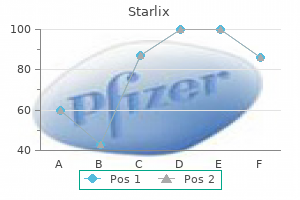
Starlix 120 mg free shipping
Cells that "favor" a selected stimulus orientation are grouped in orientation columns. Some within the inferotemporal cortex are influenced mainly by P cells, and they perform in form detection, shade imaginative and prescient, and face discrimination. M cells influence areas of the middle temporal and parietal cortex, which function in movement detection and the management of eye actions. The pinna and auditory canal convey airborne sound waves to the tympanic membrane. The three small bones (ossicles) of the center ear transmit the vibrations of the tympanic membrane to the oval window of the fluid-filled inside ear. Hearing is most delicate at about 3000 Hz because of the dimensions of the auditory canal and the mechanics of the ossicles. The cochlea of the internal ear has three major compartments: the scala vestibuli, the scala tympani, and the intervening scala media (cochlear duct). The cochlear duct is bounded on one facet by the basilar membrane, on which lies the organ of Corti, the sound transduction mechanism. When the basilar membrane oscillates in response to strain waves introduced into the scala vestibuli on the oval window, the stereocilia of the hair cells of the organ of Corti are subjected to shear forces, which open mechanoreceptor K+ channels. This leads to a membrane conductance change that modulates the discharge of neurotransmitters on to cochlear nerve fibers. High-frequency sounds best activate the hair cells near the base of the cochlea, and low-frequency sounds activate cells close to the apex. Such a tonotopic group can be current in central auditory buildings, together with the cochlear nuclei, superior olivary complex, inferior colliculus, medial geniculate nucleus, and first auditory cortex. Auditory processing at many websites in the central auditory pathway contributes to sound localization, frequency and intensity analysis, and speech recognition. It contains three semicircular canals (horizontal, anterior, and posterior) and two otolith organs (utricle and saccule) on all sides. The three semicircular canals are mutually orthogonal, so they can resolve angular acceleration of the head about any axis of rotation. In each semicircular canal, there are sensory hair cells whose cilia prolong into a cupula, which blocks the 16. Angular head acceleration displaces the endolymph and the cupula, bending the cilia. If the stereocilia bend towards the kinocilium, the hair cell is depolarized, which causes a rise within the firing rate within the afferent fiber. Acceleration of the top, as with linear motion, or change in position in relation to gravity displaces the otolithic membrane (because of the mass of the otoliths) and modifications the firing patterns of the hair cells, depending on their orientation. Central vestibular pathways embrace afferent connections to the vestibular nuclei and the cerebellum. Activation of the vestibular afferent fibers is detected by the mind as head acceleration or position change and is relayed by way of the vestibular nuclei to pathways that mediate compensatory eye actions, neck movements, and changes to posture. Taste buds are located on several sorts of papillae on the tongue and in the pharynx and larynx. Five forms of taste-receptor cells detect the five elementary qualities of taste: salty, candy, bitter, bitter, and umami. Complex flavors are signaled by the patterned activity of a number of courses of taste receptor and by central correlation with accompanying olfactory input. The thalamic relay is through part of the ventroposterior medial nucleus to the taste-receiving areas positioned in the S1 cortex and the insula. Odors are detected by olfactory chemoreceptor cells, that are continuously regenerated within the olfactory mucosa. These cells are true neurons which would possibly be endowed with a extensive selection of G protein�coupled receptors that enable the detection of hundreds of odor molecules. Individual olfactory axons project to olfactory glomeruli, particular for every stimulus sort, within the olfactory bulb.
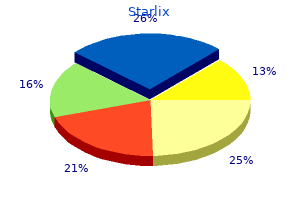
Purchase 120 mg starlix with mastercard
In addition, the hippocampus and amygdala are linked to the prefrontal cortex, the basal forebrain, and the anterior cingulate cortex. Bilateral temporal lobe lesions can produce Kl�ver-Bucy syndrome, which is characterized by lack of the ability to acknowledge the meaning of objects from visual cues (visual agnosia); an inclination to examine all objects, even harmful ones, orally; consideration to irrelevant stimuli; hypersexuality; a change in dietary habits; and decreased emotionality. The arrangement of pyramidal neurons, with their apical dendrites aligned in parallel to type a dipole sheet, is particularly favorable for producing giant area potentials. One pole of this sheet is oriented towards the cortical floor and the opposite toward the subcortical white matter. The dominant frequencies rely upon a number of elements, together with the state of wakefulness, the age of the subject, the placement of the recording electrodes, and the absence or presence of drugs or disease. If the topic is requested to open the eyes, the wave turns into less synchronized, and the dominant frequency will increase to 13 to 30 Hz, which is known as the beta rhythm. A cortical evoked potential is greatest recorded from the a part of the cranium positioned over the cortical space being activated. For instance, a visible stimulus leads to an evoked potential that can be recorded greatest over the occipital bone, whereas a somatosensory evoked potential is recorded most successfully near the junction of the frontal and parietal bones. With each repetition of the stimulus, the evoked potential happens at a set time after the stimulus. Muscle tone is completely misplaced, however phasic contractions happen in a number of muscular tissues, most notably the attention muscular tissues. Sleep-Wake Cycle Sleep and wakefulness are among the many many features of the body that present circadian (about 1-day) periodicity. A person falling asleep passes sequentially via four stages of slow-wave sleep (called phases 1 through 4) over a interval of 30 to forty five minutes. In stage 1, alpha waves are interspersed with lower frequency waves called theta waves. In stage 2, the waves gradual additional, but the slow-wave activity is interrupted by sleep spindles, which are bursts of activity at 12 to 14 Hz, and by large K complexes (large, gradual potentials). During slow-wave sleep, the muscle tissue of the physique chill out, however the posture is adjusted intermittently. The coronary heart fee and blood strain decrease, and gastrointestinal motility will increase. The ease with which people may be woke up decreases progressively as they move through these sleep stages. Sleep was as quickly as thought to be attributable to a reduced degree of exercise within the reticular activating system. However, substantial data, including the observations that anesthesia of the lower brainstem results in arousal and that stimulation in the medulla near the nucleus of the solitary tract can induce sleep, recommend that sleep is an energetic course of. Investigators have tried to discover a relationship between sleep mechanisms and brainstem networks by which particular neurotransmitters, including serotonin, norepinephrine, and acetylcholine, are used; manipulations of the degrees of these transmitters in the mind can have an result on the sleep-wake cycle. However, it will need to have a excessive worth because so much of life is spent in sleep and because lack of sleep can be debilitating. Medically necessary issues of the sleep-wake cycle embrace insomnia, bed-wetting, sleepwalking, sleep apnea, and narcolepsy. Cerebral Dominance and Language Although right-handedness represents a sensorimotor dominance of the left hemisphere and left-handedness represents a sensorimotor dominance of the right hemisphere, cerebral dominance is assigned to the hemisphere by which language is to talk; in people, the left hemisphere is the dominant hemisphere in more than 90% of both right- and left-handed people. This dominance has been demonstrated (1) by the results of lesions of the left hemisphere that produce deficits in language function (aphasia) and (2) by the transient aphasia (inability to converse or write) that results when a short-acting anesthetic is introduced into the left carotid artery. The terms sensory aphasia and motor aphasia are sometimes interchanged with receptive aphasia and expressive aphasia, respectively. The former phrases, however, are misleading: A individual with receptive aphasia may not have auditory or visual impairment, and one with expressive aphasia could have normal motor control of the muscle tissue liable for speech or writing. However, lesions within the dominant hemisphere may be giant enough to end in combined types of aphasia, as properly as sensory adjustments or paralysis of a variety of the muscle tissue used to express language. For instance, the latter scenario may happen with a lesion of the face illustration portion of the motor cortex that leads to an lack of ability to manipulate the motor apparatus needed for speaking (vocal cords, jaws, tongue, lips) and would be manifest as unclear speech because of dysarthria, a mechanical deficit. An affected particular person would, nonetheless, have the ability to write if the motor cortex serving the higher limb have been unaffected.
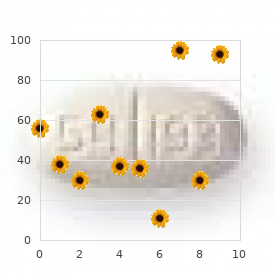
Cheap starlix 120 mg on-line
Traditionally, filtration was thought to happen on the arterial finish of the capillary, and absorption was thought to occur at its venous finish due to the gradient of hydrostatic strain alongside the capillary. However, in well-perfused capillaries, arteriolar vasoconstriction can scale back Pc in such a method that absorption on the arteriolar finish can happen transiently. With continued vasoconstriction, absorption diminishes with time as a result of Pi will increase. Hence, in the regular state, filtration and absorption throughout the capillary wall are well balanced. However, a change in precapillary resistance influences fluid motion throughout the capillary wall. The fee of fluid motion (Qf) across the capillary membrane relies upon not only on the algebraic sum of the hydrostatic and osmotic forces throughout the endothelium (P) but additionally on the realm (Am) of the capillary wall obtainable for filtration, the gap (x) throughout the capillary wall, the viscosity of the filtrate, and the filtration fixed (k) of the membrane. Because the thickness of the capillary wall and the viscosity of the filtrate are relatively fixed, they can be included within the filtration constant k. When capillaries are injured (as by toxins or extreme burns), vital amounts of fluid and protein leak out of the capillaries into the interstitial area. This improve in capillary permeability is mirrored by an increase in the filtration coefficient. Because capillary permeability is constant underneath normal conditions, the filtration coefficient can be used to decide the relative variety of open capillaries. For instance, the increased metabolic exercise of contracting skeletal muscle relaxes the precapillary resistance vessels and hence opens more capillaries. The change in stress may be countered by changes in precapillary resistance vessels (autoregulation; see Chapter 18) so that hydrostatic strain stays constant within the open capillaries. However, a severe discount in Pa normally evokes arteriolar constriction mediated by the sympathetic nervous system. However, the reducing of blood stress in hemorrhage causes a lower in blood circulate (and hence in O2 supply) to the tissue, with the end result that vasodilator metabolites accumulate and chill out the arterioles. Precapillary vessel rest additionally happens because of the lowered transmural stress (autoregulation; see Chapter 18). Consequently, absorption predominates over filtration, and fluid moves from the interstitium into the capillary. These responses to hemorrhage represent one of many compensatory mechanisms used by the physique to restore blood volume (see Chapter 19). An increase in Pv alone, as happens within the toes when an individual stands up, would elevate capillary pressure and improve filtration. However, the rise in transmural strain closes precapillary vessels (myogenic mechanism; see Chapter 18), and hence the capillary filtration coefficient actually decreases. This reduction in capillary surface obtainable for filtration prevents giant amounts of fluid from leaving the capillaries and getting into the interstitial house. In a wholesome particular person, the filtration coefficient (kt) for the whole body is approximately 0. For a 70-kg man, an elevation in Pv of 10 mm Hg for 10 minutes would improve filtration from capillaries by 420 mL. When edema develops, it often seems in the dependent components of the physique, the place the hydrostatic strain is biggest, but its location and magnitude are additionally determined by the sort of tissue. Loose tissues, such as the subcutaneous tissue around the eyes or in the scrotum, are more susceptible than agency tissues, as in a muscle, or encapsulated buildings, as in a kidney, to acquire larger portions of interstitial fluid. Some transfer of gear across the capillary wall can happen in tiny pinocytotic vesicles. The amount of material transported on this way could be very small in relation to that moved by diffusion. However, pinocytosis could additionally be responsible for the motion of huge (30-nm) lipid-insoluble molecules between blood and interstitial fluid. The number of pinocytotic vesicles in endothelium varies amongst tissues (amount in muscle > quantity in lung > amount in brain), and the quantity will increase from the arterial finish to the venous finish of the capillary. Moreover, the thoracic duct carries substances absorbed from the gastrointestinal tract. The circulate from resting skeletal muscle is nearly nil, and it will increase throughout train in proportion to the degree of muscular exercise.


